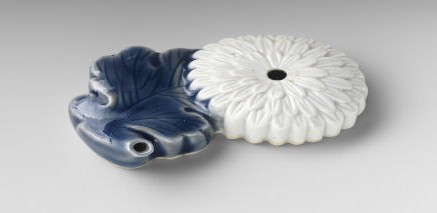
Friday, 17 October 2008
The Chrysanthemum in Japanese Art at the New York Botanical Garden
Images provided by The New York Botanical Garden
The gallery of the LuEsther T. Mertz Library at the New York Botanical Garden has held many wonderful exhibitions. Previously, these have displayed books and paintings. Now, for the first time, the exhibition offers a sumptuous display of objects venerating the Chrysanthemum in Japanese Art. From decorative screens to hanging scrolls, a kimono, fabric stencils, to small function objects of exquisite beauty, the exhibition presents 32 magnificent items to its visitors.

Water dropper in the shape of a chrysanthemum
The Metropolitan Museum of Art, Bequest of Dr. and Mrs. Roger G. Gerry
Image © The Metropolitan Museum of Art
For centuries Japan was an inward-turning country. With the exception of China and Korea, their borders were closed to foreigners. Gardens were created utilizing the country's rich native flora. And a diversity of decorative arts, from painting and embroidery to ceramics, lacquerware and metal working, celebrated the countryside's plants and animals. Folk tales, myths, and legend were interwoven as well.
It is so appropriate that Kiku, The Art of the Japanese Chrysanthemum will have had its opening on 18 October. Since the Showa era it is on this day that Kinryuzan Sensoji Temple in Asakusa celebrates Kiku-kuyo Festival Day, a memorial service for chrysanthemums. On this day gekuugiku, old chrysanthemums that have been donated to the temple are replaced with new ones brought by parishioners, called kengiku. This memorial service is related to choyo-no-utage in ancient China.
Choyo-no-sekku was one of the serial celebrations based on Chinese lunar calendar praying for health and happiness. Month and day with double numbers: 3rd March, 5th May, 7th July, are especially fortunate. The number 9 was believed the most auspicious of all the single digit figures, so double nines - 9th September - would bring the best fortune. A happy ceremony, the September celebration was associated with the seasonal beauty of the chrysanthemum. Since the flower symbolizes immortality, people would treat themselves to kiku no sake, floating chrysanthemum petals on their drinks.
The festival was later brought to Japan as kiku-no-kisewata. Sweet bean paste cakes, tinted pink and shaped like chrysanthemums, are a special treat at this time. They're toped with a small dab of white bean paste that represents a little piece of cotton that would be placed on top of chrysanthemums on the festival eve, 8th September. It is left overnight to absorb the dew. In the 12th century people prayed for long life by purifying themselves with the dew-soaked-cotton.
Both of these ceremonies are based on a mythical story about the magical powers of the Kannon sutra and chrysanthemums. According to the kikujido legend, if four lines of the sutra (four lines out of eight that praise the Kannon) are written on a chrysanthemum leaf, the dew that forms on this leaf will become an elixir that brings 800, 900 or even 1000 years of life, also giving those who drink it a youthful appearance.
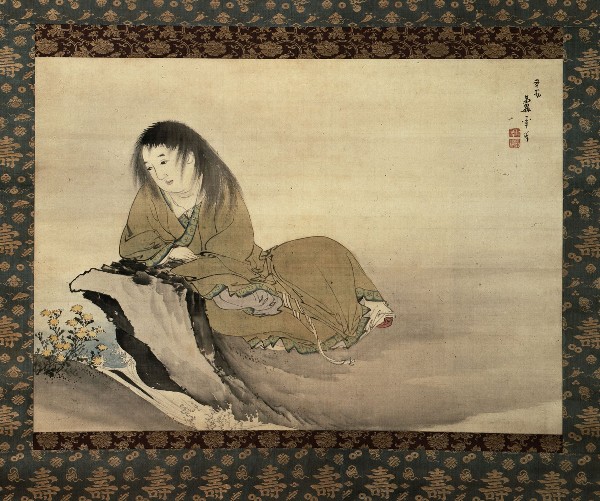
Kikujido, Nagasawa Rosetsu, late 18th century
Collection of Raphael and Jane Bernstein
Clad in an elegant robe, a crimson court shoe peeking from beneath his under-robe,
Kikujido peers at the yellow chrysanthemums across a tumbling brook.
Reduced to its essence, kikujido, the chrysanthemum boy, was an exile who wrote poems and magic words on chrysanthemum petals which he floated downstream. A figure from Chinese legend, Kikujido (child of the benevolent chrysanthemum) was a page boy at the time of the ancient dynasty of Western Zhou. Banished from court and sent into exile, just before he left the Emperor told Kikujido a phrase containing the secret to long and healthy life to thank him for all his loyalty. Settling in a valley full of chrysanthemums, Kikujido spent his days writing the secret phrase on the petals of the flowers so he would not forget it. Each night the dew which washed away his efforts was transformed into a magic potion, the elixir of everlasting youth.
.
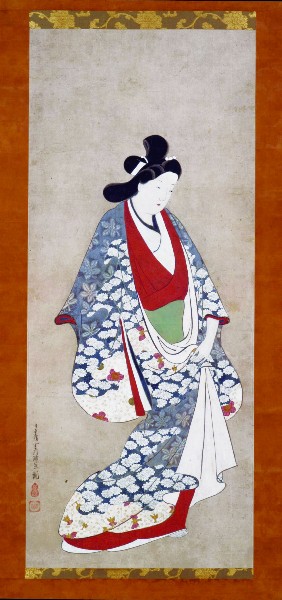
Standing Beauty, School of Hishikawa Moronobu, 17th century
Roger L. Weston collection
Kimono must be seasonally appropriate. Wearing fall colors and fall patterns for the autumn, this courtesan's outer kimono is embellished with chrysanthemum flowers and autumn leaves. She raises it with one hand, thus revealing her dark crimson under-robe and undergarments of black and white.
Beginning in the mid-17th century the Ukiyo or floating world of Japan centered on the Yoshiwara pleasure quarter that flourished in the city of Edo. Highly idealized representations of courtesans, oiran and entertainers, geishaare the most common and compelling images of ukiyo-e, pictures of the floating world. Literally and symbolically, they were the central figures of the ukiyo, embodying physical beauty, cultural refinement and, quite often, erotic love.
Age, social status and gender all played a part in the appearance of the kimono, from the richness of the fabric, depth of color, patterns, underlayers in coordinating colors, and undergarments. High born Japanese ladies would wear as many as twelve layers, the outermost layer providing the garment's colorful and artistic appeal. All the other layers draped one after the other over the innermost layer of pure white silk. Sumptuary laws regarding excessive expenditures on women's kimono caused some to spend their money on extravagant undergarments instead of a more obvious outer kimono.
.
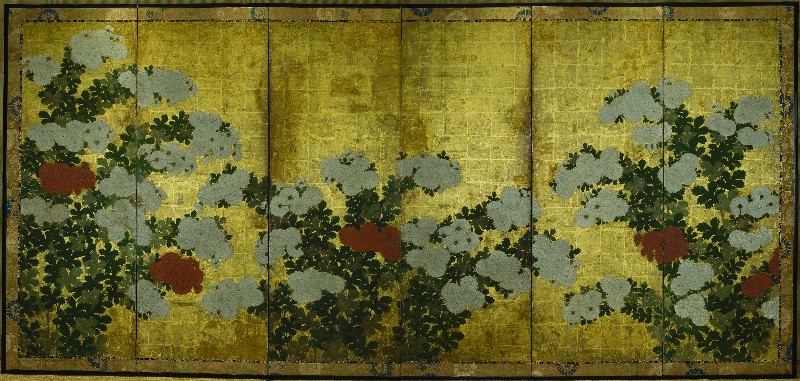
Chrysanthemums, six-panel folding screen; ink and color on gilded paper, 18th century.
Property of Mary Griggs Burke
Photograph by Bruce Schwartz
Gold was used to create a background rich with beauty, with overlapping edges of the sheets effecting variation of hue. Colors often have a finer luster when painted over gold. Their color coming from malachite, an outline of ink emphasizes the green leaves and stems. Pigment for the red flowers was made from cinnabar and mercury, and touches of blue made from ground lapis lazuli. Layers of gofun, oyster shell gesso give a bas relief effect to the white chrysanthemum petals.
Flowers of the four seasons play a central role in folding screens, with pine trees, wisteria, cherry blossoms, irises, autumn grasses, and, of course, chrysanthemums. Screens with six panels, or with two leaves are common. Four-leaved screens are uncommon, and eight-leaved screens are rare. Typical full-sized folding screens measure five to six feet high.
.
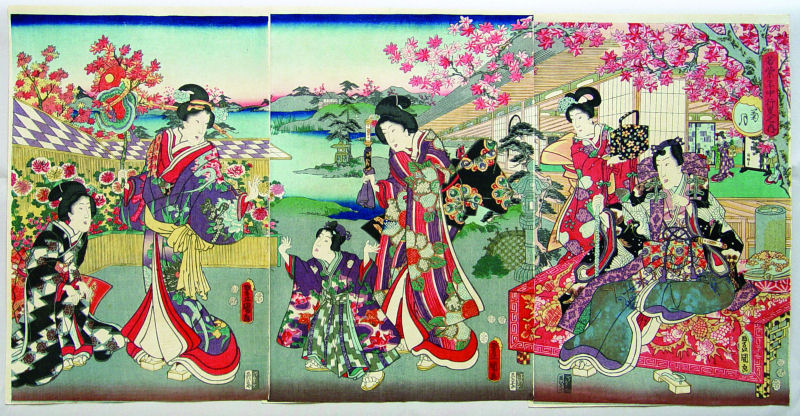
Kiku zuki, Chrysanthemum Month. Utagawa Kunisada, mid-19th century
Joan B. Mirviss LTD
Highly symbolic, Kiku Zuki, Chrysanthemum Month, marks a change of of season and of clothing.Especially auspicious is the ninth day of the ninth month - September in the lunar calendar but October in the solar calendar. Popular activities include drinking chrysanthemum wine and sipping tea made from chrysanthemum petals. Chrysanthemums are admired in gardens and floral exhibitions, and the flowers are shown reverence by painting them and writing poems in their honor. It is also a time for momijigari, (from the Japanese momiji, red leaves and kari, hunting) the Japanese tradition of going to visit scenic areas where leaves have turned red in the autumn.
.
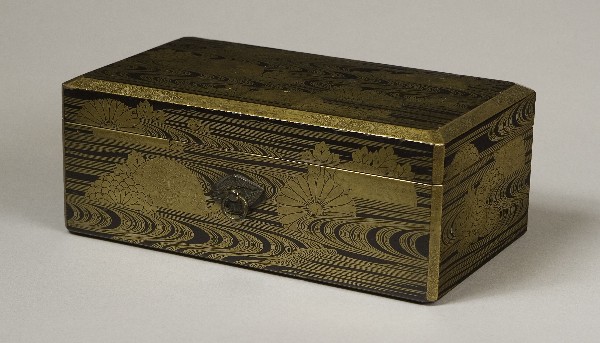
Lidded box with chrysanthemums and flowing water, 17th century
Mary and Jackson Burke Foundation
Photograph by Bruce Schwartz
Chrysanthemums floating on water is a theme associated with Kikujido. Here, ripples of golden water and chrysanthemums on a black lacquerware box were created with sprinkled gold maki-e. Some outlines were created using this technique, wherein finely powdered gold is sprinkled on the wet lacquer. Elsewhere, thin, fine lines of black lacquer create the details. Even the beveled edges are embellished with tiny chrysanthemum flowers and scrolling leaves. What couple be so rare as to keep it in such a wonderful box. Love poems, perhaps.
.
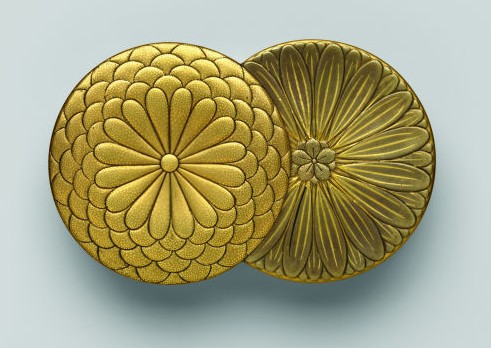
Incense box in the shape of overlapped chrysanthemums, late 19th century
Gold maki-e, gold foil, and gold dust on lacquer.
The Metropolitan Museum of Art, Bequest of Stephen Whitney Phoenix
Image © The Metropolitan Museum of Art
This magnificent little box would fit easily in the palm of your hand. It is just 1-3/8 inches high by 2-7/8 inches wide by 4-5/8 inches long. Closed, it gives the appearance of a pair of boxes nested together, their lids patterned like two different types of chrysanthemums. There's an interior tray with an image of kikujido done in gold maki-e, a traditional multilayered lacquering technique where fine gold dust is sprinkled to form a design or picture on a lacquer surface before it hardens.
.
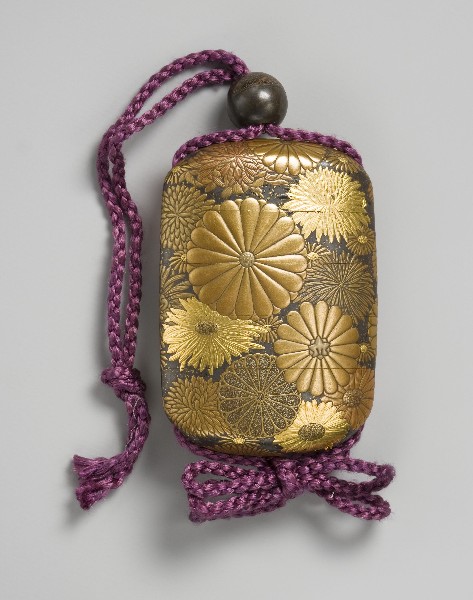
Inro with design of chrysanthemums, late 18th century
Gold and silver maki-e on black lacquer.
Michael R. Bernstein collection
Photograph by Sheldan Collins.
A privilege of the samurai warrior, inro have several compartments, kept together by a cord running through the himotoshi, holes alongside each compartment. The cord ends in a knot to keep it from pulling loose, and is fastened with an ojime, a small bead, at the top. Inro, like the ojime and netsuke they were associated with, evolved over time from strictly utilitarian articles into objects of high art and immense craftsmanship.
Kimono don't have pockets. Some items were carried tucked into the kimono's deep sleeves. Other things were often carried by hanging them from the obi, or sash. In the beginning sagemono were simple little leather bags closed by means of a cord and used for carrying money. Later on they were made of brocade. The most famous sagemono type is the inro. The portable version which came into use during the 16th century was more rounded and flattened than the original 2-compartment square box for seal and ink pad kept at home. They evolved into multi-compartment little devices that could be used for seals, ink pads, medicines, and other small objects.
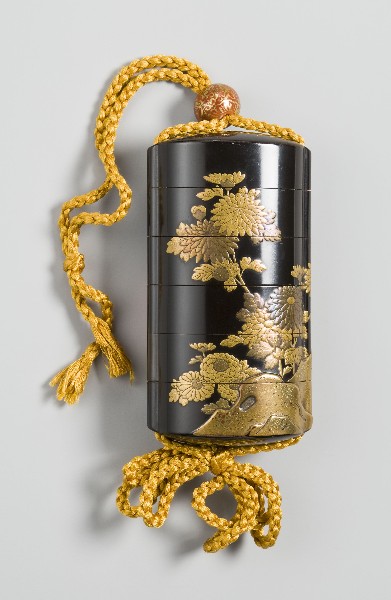
Inro with design of chrysanthemums and rocks.
Gold and silver maki-e on black lacquer.
Michael R. Bernstein collection
Photograph by Sheldan Collins
.

Water dropper in the shape of a chrysanthemum
The Metropolitan Museum of Art, Bequest of Dr. and Mrs. Roger G. Gerry
Image © The Metropolitan Museum of Art
Dainty indeed, this miniature container is but 2-5/8 long by 2-1/2 wide by 3/4 inch high. Suiteki, water droppers, are used to dribble water on an inkstone, as an ink stick is rubbed to create the liquid ink for calligraphy or brush painting. As an aside, when I studied sumi-e many years ago, my instructor said that the act of preparing ink was the act of preparing to draw. It should be done mindfully, with patience, and not as something to be rushed. With an accoutrement such as this little container of chrysanthemum flower and leaves, it would be easy to stay in the moment.
The exhibition will be open through January 11, 2009. Do visit. You'll be glad you did.